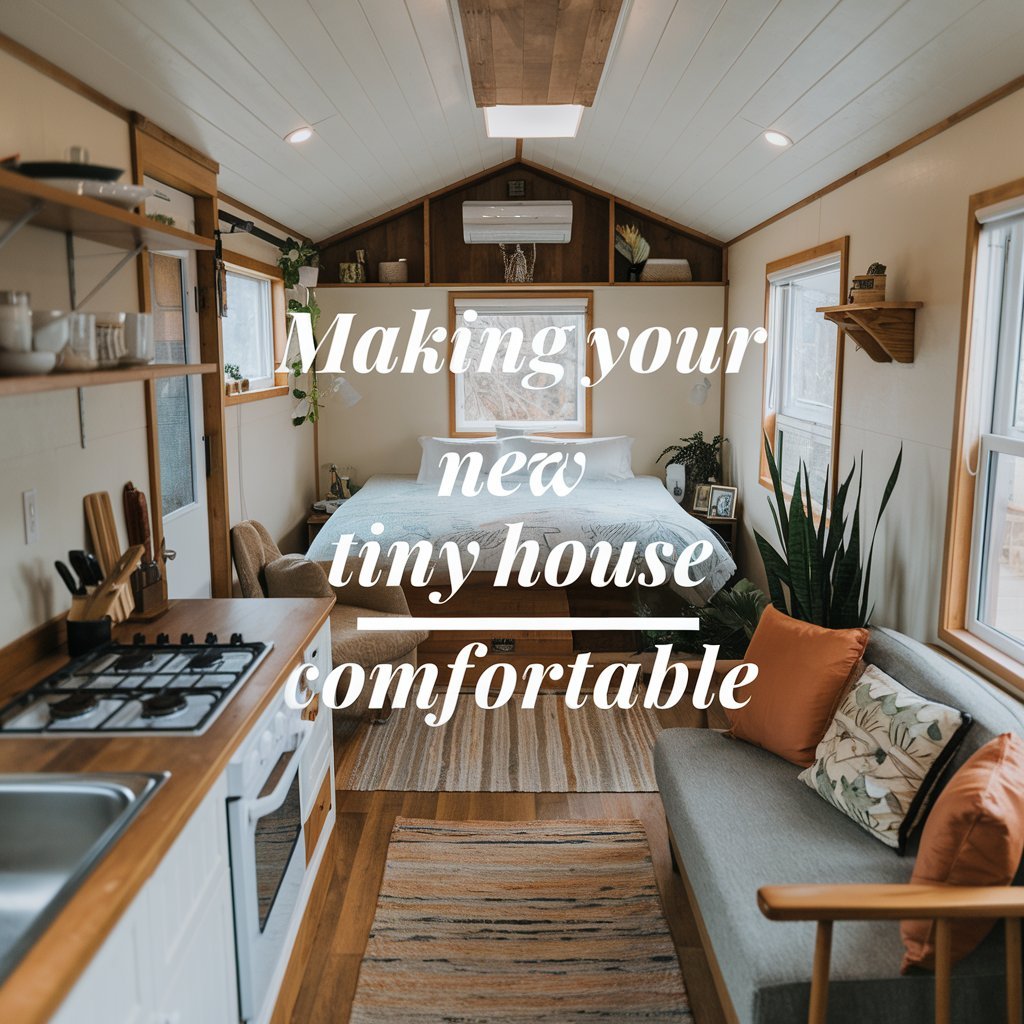The tiny home movement continues to grow as more Americans embrace minimalist, eco-friendly lifestyles. Take Rafael and Kristi Bugajski, for example. After constructing their custom 220-square-foot dwelling, “The Tiny House Escapade,” they discovered firsthand how smart design turns cramped quarters into livable spaces.
Living small requires big creativity. Every inch counts when square footage is limited, but clever organization can make even micro-homes feel spacious. This guide shares battle-tested methods from real residents like the Bugajskis, who transformed their North Carolina build into a functional masterpiece.
You’ll learn how to rethink walls, floors, and furniture to create hidden compartments and dual-purpose zones. These approaches blend practicality with style, proving that downsizing doesn’t mean sacrificing comfort. Whether you’re building new or optimizing an existing layout, these ideas adapt to any skill level or budget.
Key Takeaways
- Vertical spaces like walls and ceilings offer untapped storage potential
- Multifunctional furniture reduces clutter while serving multiple needs
- Custom-built solutions can adapt to irregular or underused areas
- Lightweight, stackable containers keep items accessible yet out of sight
- Seasonal rotation prevents overcrowding in limited square footage
Introduction to Tiny Home Living and Storage Challenges
Americans are increasingly trading square footage for financial flexibility and eco-conscious choices. This shift fuels the tiny home movement, where compact dwellings redefine modern living. Over 10,000 such structures now dot the U.S. landscape, proving small spaces can deliver big lifestyle benefits.

The Rise of the Tiny Home Movement
Soaring housing costs and environmental concerns drive this housing revolution. Millennials and retirees alike find freedom in mortgage-free living and reduced carbon footprints. Unlike traditional homes, these micro-residences demand strategic layouts that convert walls into storage hubs and stairs into drawers.
Why Storage Optimization Matters
Clutter becomes oppressive in 300 square feet. Smart storage design separates functional tiny homes from cramped trailers. Residents report 68% less stress when every pot and jacket has a designated spot. Early planning prevents overwhelming messes and helps maintain the movement’s minimalist ethos.
Creative solutions transform limitations into advantages. Wall-mounted desks fold into artwork. Staircase cubbies hide seasonal gear. This approach turns tight quarters into adaptable environments where every inch serves multiple purposes.
Understanding the Challenges of Compact Living Spaces
Compact living demands a radical rethinking of how we interact with our surroundings. Unlike conventional homes, micro-dwellings amplify the consequences of poor planning. Residents quickly learn that spatial awareness determines their quality of life.

Limited Square Footage Concerns
Traditional storage methods collapse under tiny house constraints. A standard kitchen cabinet consumes 15% of a 150-square-foot floor plan. This forces residents to innovate with modular systems and vertical designs.
| Storage Approach | Traditional Home | Tiny Home |
|---|---|---|
| Closet Depth | 24 inches | 12 inches |
| Shelving Height | 7 feet | Floor-to-ceiling |
| Furniture Function | Single-purpose | Multi-use |
Wall cavities become pantry nooks. Stair risers transform into shoe cubbies. This adaptive mindset turns architectural limitations into functional triumphs.
Overcoming Clutter and Disorganization
One misplaced item can paralyze daily routines in compact areas. Successful residents implement three non-negotiable rules: weekly purges, labeled containers, and vertical stacking systems.
Rotating seasonal gear prevents overcrowding. A family of four reduced their wardrobe by 60% using vacuum-sealed bags under seating. Clear bins allow instant visual access while keeping surfaces clear.
Discipline becomes liberation in tiny spaces. When every belonging earns its keep, chaos gives way to purposeful living. The result? Spaces that feel expansive despite their modest dimensions.
Essential Tips for Maximizing Storage in a Tiny House
Designing a functional compact dwelling requires reimagining how spaces serve multiple roles. Smart layouts turn architectural limitations into advantages, where walls become pantries and staircases morph into clothing racks. The key lies in selecting features that adapt to your lifestyle while preserving visual calm.

Identifying Must-Have Storage Features
Begin by mapping daily routines. Track which items you grab hourly versus those used monthly. This audit determines where to install quick-access zones versus deep-storage areas. Frequent-use kitchen tools might live on magnetic wall strips, while holiday decor tucks into ceiling-mounted pods.
Furniture that moonlights as storage doubles your square footage’s value. Consider benches with lift-up seats for blankets or beds with hydraulic compartments for shoes. One Colorado couple stores their entire off-season wardrobe in a dining table that converts to a workspace.
Vertical systems unlock overlooked potential. Floor-to-ceiling shelves with adjustable dividers accommodate changing needs. A family in Oregon uses track-mounted baskets along their kitchen wall – perfect for spices during cooking hours and art supplies after dinner.
Built-in solutions outshine store-bought alternatives every time. Custom cabinetry fills awkward corners, like triangular shelves under sloped roofs. These tailored approaches ensure no space goes wasted, creating a home that feels intentionally designed rather than cramped.
Smart Storage Solutions for Every Room
Transforming tight spaces requires room-specific strategies that balance accessibility with aesthetics. Let’s explore how to amplify functionality in the heart of the home and its most compact counterpart.

Reimagining Kitchen Efficiency
Cabinet sides become unexpected allies in small kitchens. Install narrow shelves on exterior panels to display coffee mugs or herb gardens. One Minnesota homeowner stores cutting boards vertically between their fridge and wall using this method.
Flip existing surfaces into secret workhorses. The backs of pantry doors hold magnetic spice racks, while under-cabinet hooks keep measuring cups within reach. Overhead storage above stoves stores bulk grains in clear containers – visible but out of the way during daily cooking.
Bathroom Space Expansion Tactics
Corners often gather dust in standard layouts. Angled shelves transform these voids into shower caddies or toilet paper towers. A Portland couple installed triangular cabinets above their toilet, gaining space for 12 bath towels.
Mirrors do double duty when framed with recessed compartments. These hidden nooks store dental essentials while maintaining sleek lines. Floating vanities with pull-out drawers create visual lightness, proving that solutions can be both practical and stylish.
Multi-Purpose Room Design in Tiny Homes
Smart tiny home layouts thrive on spatial versatility. Rooms morph into different configurations like actors changing roles on stage. The Bugajskis’ bathroom demonstrates this perfectly – washing dogs, storing laundry gear, and serving as a dressing area beneath their 4-foot bedroom ceiling.

Transforming Living Areas for Dual Functions
Daylight dictates room purposes in compact dwellings. Morning sun illuminates fold-down desks for remote work. By afternoon, the same surface becomes a puzzle table, then transforms into a buffet for evening gatherings. Built-in bench seats with hidden compartments handle shoes during the day and extra bedding at night.
Consider these space-saving swaps:
- Walk-in pantries with pull-out countertops for meal prep
- Closet benches storing purses under flip-up cushions
- Staircase landings converted into reading nooks
Adapting Spaces for Work, Play, and Rest
Zoning techniques create invisible boundaries within rooms. A living area might feature:
| Zone | Day Use | Night Use |
|---|---|---|
| Central Table | Office Desk | Dining Surface |
| Window Alcove | Plant Shelf | Meditation Corner |
Movable partitions like room dividers on wheels help transition between activities. Wall-mounted fold-out desks disappear when movie night begins. This fluid approach lets 150 square feet feel like 500 through intentional design that honors changing daily rhythms.
Creative Cabinet and Shelf Innovations
Revolutionary storage designs transform how we interact with compact living areas. By reimagining cabinetry and shelving, residents unlock hidden potential in overlooked spaces. These solutions blend practicality with visual appeal, turning functional elements into design features.

Overhead Storage and Side Shelves
Install shelves above appliances to capitalize on vertical real estate. Open cube designs above stoves store cookbooks or spices while maintaining airflow. One Texas family grows herbs on narrow side shelves attached to their refrigerator cabinet – fresh flavors within arm’s reach.
Cabinet exteriors become display zones when fitted with 4-inch ledges. These slim additions hold coffee mugs or framed photos without encroaching on walkways. For renters, adhesive hooks on cabinet doors create instant hanging space for utensils or towels.
Under-Stair and Hidden Compartment Ideas
Staircases morph into storage powerhouses with custom-built drawers. A Seattle couple stores camping gear in pull-out bins beneath each step. Angled risers accommodate shoes, while the hollow space under the landing houses their vacuum cleaner.
Concealed compartments maintain sleek interiors. Magnetic panels disguise spice racks behind artwork. Fold-down tables tuck into walls, revealing chalkboard surfaces for notes. These space-saving tricks prove that smart design outsmarts square footage limitations.
Innovative Closet and Wardrobe Organization
Revamping wardrobe systems unlocks hidden potential in compact dwellings. Take Kristi and Rafael’s 18-square-foot closet – it holds work uniforms, formal wear, and everyday outfits through strategic planning. Their approach demonstrates how to balance preservation needs with spatial constraints.

Folding vs Hanging: Space Efficiency Showdown
Vertical stacking trumps horizontal hanging in most cases. Folded garments in drawers occupy 63% less space than those on hangers, according to home organization studies. The Marie Kondo folding technique lets jeans and sweaters stand upright like files, creating instant visibility without drawer chaos.
Reserve hanging rods for wrinkle-prone items. Rafael’s dress shirts occupy just 14 inches of closet width, while Kristi’s scrubs fill three stacked drawers below. Adjustable shelving adapts to seasonal changes – bulkier winter layers get lower compartments, summer tees claim higher spots.
Effective systems combine both methods:
- Install shallow shelves above rods for folded accessories
- Use slimline hangers for delicate blouses and suits
- Rotate clothing quarterly using vacuum-sealed under-bed bags
Drawer dividers transform single compartments into multi-item zones. One section holds socks, another belts – no more morning scavenger hunts. This hybrid approach maintains order while accommodating diverse wardrobe needs.
Harnessing Vertical Space in Your Tiny Home
Reaching upward unlocks new possibilities in compact dwellings. Clever use of height creates breathing room below while adding functional zones. This approach turns empty air into valuable real estate for daily living.
Lofted Storage and Upper-Level Organization
Building upward solves multiple layout challenges. The Bugajskis’ 13.5-foot structure houses two sleeping lofts above their kitchen and bathroom. Elevated platforms keep bedding private without consuming main-floor space.
Upper levels become storage workhorses when designed strategically. Install shallow cabinets along loft railings for books or folded linens. One Oregon family stores off-season clothing in weatherproof bins beneath their mattress platform.
Utilizing Wall-Mounted Systems
Blank walls transform into activity hubs with modular systems. Pegboards in New Mexico homes hold cooking tools by day and craft supplies by night. Magnetic strips keep knives accessible yet safely out of reach.
Don’t overlook transitional spaces. Shelves above doorways display plants or collectibles without blocking pathways. A Texas couple uses this trick to store board games in decorative baskets – functional décor that serves dual purposes.



